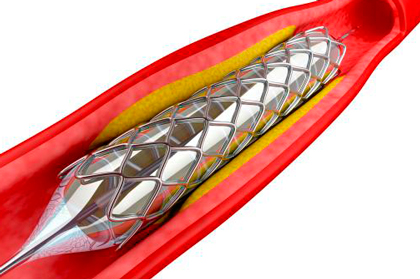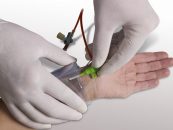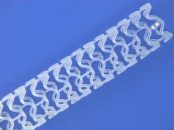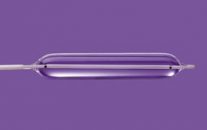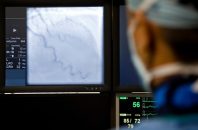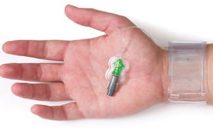Courtesy of Dr. Brian Nazareth Donato. The relative safety of drug-eluting stents (DES) and conventional bare-metal stents (BMS) in primary angioplasty (percutaneous coronary intervention, PCI) in patients with ST elevation myocardial infarction (STEMI) is still subject of debate. A search was carried out using Medline, CENTRAL, EMBASE, TCTMD and Cardiosource. There were 9673 patients included,…
Stem Cells: A New Alternative for Refractory Angina?
Courtesy of Dr. Agustín Vecchia. Recent investigations and certain randomized trials suggest that the administration of CD34+ stem cells to patients with refractory angina improves exercise tolerance and decreases angina frequency. The following is a phase 3, randomized, double-blind multicenter trial comparing three groups of patients: active treatment through intramyocardial administration of CD34+ stem cells (autologous, purified), standard of care…
No Extra Benefit for Combined Use of Bivalirudin and Transradial Approach
The aim of this meta-analyzis was to study the relation between bivalirudin and access site in patients undergoing acute coronary syndrome (ACS). Both bivalirudin and the transradial access site are strategies aiming at reducing bleeding complication in patients with ACS undergoing invasive approaches. The interaction of both strategies and the potential benefits of their combined use…
BVS: Comparable to Second-Generation DES in Complex Lesions
A center carrying out a mid- to long-term follow-up of the performance of everolimus-eluting bioresorbable scaffolds (Absorb) observed that this new device has an acceptable rate of major cardiovascular events, when compared to second-generation drug-eluting stents. Furthermore, although the population was complex and non-selected, no cases of early thrombosis were reported. This study enrolled 249 patients…
Non-Compliant Balloons Improve Bifurcation Outcomes
Courtesy of Dr. Carlos Fava. The provisional approach is the standard strategy to treat bifurcations, but it might cause dissection of the ostium, a serious complication of the side branch. The use of non-compliant balloons (NCB) ensures uniform, constant, and controlled expansion along balloon length, reducing the risk of dissection. The COBIS II registry enrolled…
Visual Assessment and Misinterpretation of Coronary Lesion Severity
Courtesy of Dr. Pablo Baglioni. The visual interpretation of coronary angiographies is still used to decide for or against revascularization of ambiguous coronary lesions. Multiple factors other than stenosis degree, have been associated with the functional significance of lesions. The aim of this study was to analyze the ability of interventionists to visually assess…
DAPT after PCI with EES: 6 or 12 Months?
Original Title: 6-Month versus 12-Month Dual-Antiplatelet Therapy Following Long Everolimus-Eluting Stent Implantation. The IVUS-XPL Randomized Clinical Trial. Reference: Hong et al. JACC Cardiovasc Interv. 2016 May 11. [Epub ahead of print] Courtesy of Dr. Brian Nazareth Donato. This publication stems from the IVUS-XPL published by JAMA in November 2015. This study presents outcomes on the…
Tissue Protrusion after DES: Adverse Events at Long Term?
Original Title: Tissue Protrusion after Stent Implantation. An ADAPT-DES Intravascular Ultrasound Substudy. Reference: Fuyu Qiu et al. J Am Coll Cardiol Intv. 2016;9(14):1499-1507. After DES implantation we may observe tissue protrusion (plaque or thrombus) relatively often, especially in unstable lesions; however, its clinical impact has not been studied. The aim of this study was…
Retrograde Technique: High Success Rate in CTO
Original Title: Outcomes With the Use of the Retrograde Approach for Coronary Chronic Total Occlusion Interventions in a Contemporary Multicenter US Registry. Reference: Dimitri Karmpaliotis et al. Circ Cardiovasc Interv. 2016 Jun;9(6). This study evaluated the safety and efficacy of the retrograde technique for chronic total occlusions. Researchers compared retrograde vs. anterograde technique outcomes…
All-Spectrum Transradial Approach: Safer than Femoral
Original Title: Radial vs femoral access for coronary interventions across the entire spectrum of patients with coronary artery disease: a meta-analysis of randomized trials. Reference: Ferrante G et al. J Am Coll Cardiol Intv. 2016; Epub ahead of print. Regardless the type of coronary syndrome, the transradial approach results in lower mortality and complications…
Radiotherapy: Post PCI Cardiovascular Death Predictor
Original Title: Long-Term Mortality in Patients With Radiation-Associated Coronary Artery Disease Treated with Percutaneous Coronary Intervention. Reference: Reed GW et al. Circ Cardiovasc Interv. 2016 Jun;9(6). Courtesy of Dr. Brian Nazareth Donato. Radiotherapy is often used to treat malignant tumors; however, it is associated with adverse cardiovascular effects such as constrictive pericarditis, valve deterioration…
